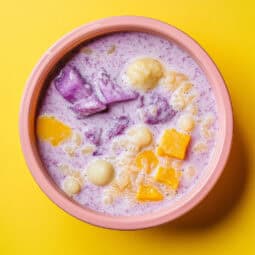
Filipino Binignit (Ginataang Halo-halo)
The Binignit's unique charm lies in its mesmerizing purple hue from ube and the harmonious blend of local Filipino ingredients - from chewy rice balls and colorful tapioca pearls swimming in creamy coconut milk to the tender chunks of root crops and sweet tropical fruits, creating a beloved Visayan dessert soup that's especially meaningful during Holy Week celebrations.
Equipment
- Large Heavy-Bottom Pot (Kaldero) For even heat distribution and preventing burning
- Wooden Spoon (Sandok Kahoy) For gentle stirring without breaking ingredients
- Measuring cups and spoons (Panukat) For accurate measurements
- Sharp knife and cutting board For uniform ingredient preparation
- Colander (salaan) For draining cooked sago pearls
- Medium bowls For ingredient preparation
Ingredients
For the Base:
- 4 cups coconut milk gata - First and second extraction
- 2 cups water tubig
- 1 cup granulated white sugar asukal
Root Crops and Fruits:
- 1 cup sweet potatoes kamote, diced into 1-inch cubes
- 1 cup taro roots gabi, diced into 1-inch cubes
- 1 cup purple yam ube, diced into 1-inch cubes (optional)
- 1-2 cups cooked ube halaya ube jam
- 2 cups plantains saging na saba, diagonally sliced
- 1 cup ripe jackfruit langka, sliced into strips
Add-ins:
- 2 cups colorful sago/tapioca pearls precooked
- 12-20 pieces glutinous rice balls bilo-bilo
Instructions
- Before starting, prepare all your ingredients: dice the sweet potatoes, taro roots, and purple yam into 1-inch cubes. Slice the plantains diagonally and cut the jackfruit into strips. Cook your sago pearls according to package instructions and set aside.
- Make your bilo-bilo by mixing glutinous rice flour with water until you can form small balls slightly smaller than marbles. Set these aside.
- Fill your large pot with 2 cups of water and bring it to a boil over medium-high heat. Once boiling, add 1¾ cups of coconut milk and wait for it to boil again.
- Lower the heat to medium-low and add your diced sweet potatoes, purple yam, and taro roots. Let these simmer gently for 8 minutes, stirring occasionally to prevent sticking.
- Pour in the remaining coconut milk and add the sugar. Gently drop in your prepared bilo-bilo. Let everything simmer for 7 minutes, stirring gently from time to time. You'll know the bilo-bilo is cooked when they float to the surface.
- Add your sliced plantains and the ube halaya. Stir well to dissolve the ube jam into the coconut milk. Cook for 2 minutes.
- Add the jackfruit pieces and cook for another 2 minutes, stirring gently.
- Finally, add your pre-cooked sago pearls and simmer for just 1 minute more. The sauce should now be thick and creamy, and all ingredients should be tender.
- Turn off the heat and let your Binignit rest for 5 minutes. This helps the flavors settle and the sauce thicken slightly more.
- If the Binignit is too thick, you can add a little warm coconut milk. If it's too thin, simmer it a bit longer or add more ube halaya.
- Serve your Binignit either hot or cold in individual bowls. You can add an extra drizzle of coconut milk on top if you like.
- Store any leftovers in the refrigerator for up to 3 days. When reheating, do so gently over low heat or in the microwave, adding a splash of coconut milk to loosen the mixture.
Tips from Lola's Kitchen
- Use fresh coconut milk when possible for the best flavor
- Make bilo-bilo slightly smaller than a marble for proper cooking
- Cook root crops separately if you want to ensure even cooking
- Add sugar gradually and taste as you go
- Stir from the bottom to prevent ingredients from sticking
- The consistency should be thick but still soup-like
Nutrition
Calories: 378kcalCarbohydrates: 43gProtein: 3gFat: 24gSaturated Fat: 21gPolyunsaturated Fat: 0.3gMonounsaturated Fat: 1gSodium: 29mgPotassium: 485mgFiber: 1gSugar: 32gVitamin A: 2777IUVitamin C: 8mgCalcium: 28mgIron: 4mg
Tried this recipe?Let us know how it was!